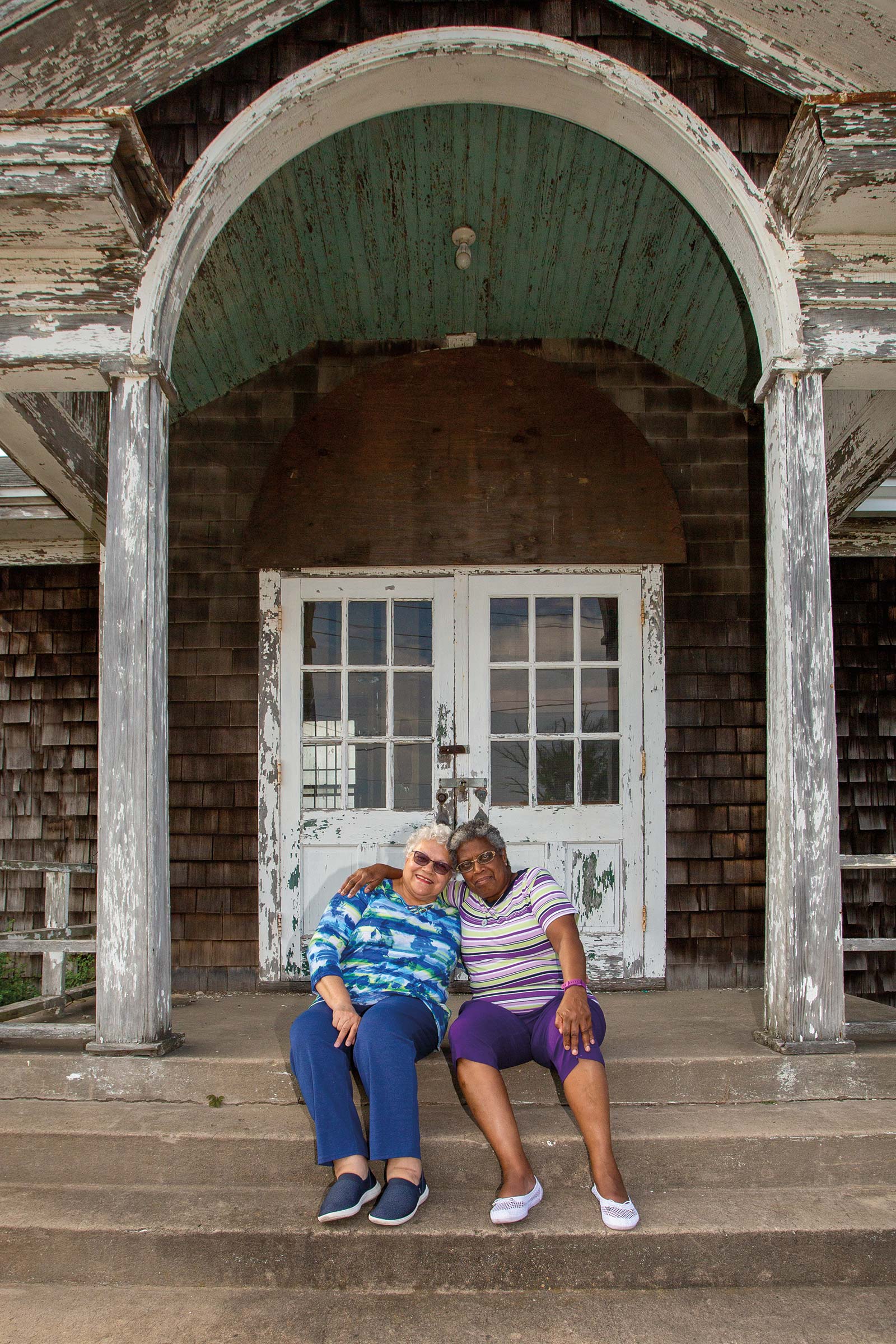
Edification and uplift were on the curriculum at the segregation-era Nassau School, whose former students want to preserve this happy part of their past
By Chris Beakey | Photographs by Carolyn Watson
From the September 2020 issue

Years from now, when local historians recount the effort to save the Nassau School, an architecturally distinct building just steps from the roaring traffic at the Five Points intersection, they’re bound to spotlight Sandra Neal, Jeanette Williams Peterson and other former students of a certain age. Their memories and the circa-1922 edifice are testaments to a community where children were protected yet challenged to prepare themselves for successful lives.
“The school was where we found our sanctuary, but it was part of a larger neighborhood where we all felt connected,” recalls Neal, who attended grades one through six in the two-room building prior to desegregation. “The church was right across the street, and farther down was Al Wiltbank’s store where we got penny candy ... and at the intersection of Route 1 was the Five Points Beer Garden, with a white side and a black side.”
“It was a community that took care of everybody,” adds Peterson, who attended the school from the first through fifth grades. “My dad was a cook who was known all over town. We played outside but made sure we were home when that street light came on. We had teachers who really cared and who spent plenty of time making sure you learned. Back in those days in our neighborhood they helped you, but you really had to help yourself.”
Most of the physical aspects of that neighborhood — known as Belltown — have disappeared. The former John Wesley United Methodist Church has been vacant for years. The general store and the beer garden are distant memories to residents who now have vast shopping and dining options for miles along Route 1. And without strong support from the Southern Delaware Alliance for Racial Justice and the Nassau School Coalition, there’s no guarantee the school wouldn’t have been damaged or moved as the Five Points intersection is redeveloped by the Delaware Department of Transportation, which owns the building. DelDOT is working with the coalition to preserve it, but eventually the group will have to buy the school from the state and raise additional funds to turn it into a museum.
“We’re a diverse group who are absolutely committed to preserving and restoring this school to remember a part of our history,” says coalition member Drew McKay of Lewes. “We can’t do that with a historical marker. We want a building people can go into — a physical place where people can learn about life during segregation.”
If the coalition succeeds, it will likely be due to the influence of several civic organizations, current and retired pastors of local churches, and help from real estate developers as well. Together, they’re determined to replicate similar efforts that have repurposed school buildings from the segregation era as educational and community gathering places for years to come.
History rooted in discrimination
One of the best-known efforts to save Delaware’s segregation-era schools was the renovation of the Rabbit’s Ferry School off Robinsonville Road near Love Creek. Like Nassau, it was one of more than 80 schools built for African American students by Delaware industrialist and philanthropist Pierre S. du Pont between 1922 and 1925. Today it’s a community center serving many different groups, including members of the Israel United Methodist Church.
Architecturally, the Rabbit’s Ferry and Nassau schools are very similar, as described in detail by former Delaware State University Associate Provost Bradley Skelcher, author of “African American Education in Delaware: A History Through Photographs, 1865-1930.”
“[D]uPont hired James O. Betelle, an architect who was also a professor at Teacher’s College at Columbia University, to design the schools,” Skelcher wrote. “There were plans for one-, two- and three-room school buildings that were designed to look like homes. The thought was that this would reduce trauma for young children because it would look like they were entering another home when they went to school.”
Architecture buffs may be quick to notice features such as Nassau’s arched portico and the large windows and elegant woodwork at both schools, all of which are also intentional and practical, Skelcher adds.
“The schools were designed to maximize interior space to allow good air quality, with natural light that was considered better for reading than artificial light. They also had efficient and modern heating, interior wash rooms and efficient ventilation to air out the students’ coats. The exteriors were in the Classical Revival Style, which was popular in the 1920s during a time of nostalgia for the past,” Skelcher says.
Design considerations aside, du Pont was focused on the future when he embarked on the project as a philanthropic and business endeavor. As chairman of General Motors and president of E.I. du Pont de Nemours & Co., he was concerned about the poor quality of Delaware’s public school system for students of all races, and about its impact on his workforce.
Low attendance among African American students was a problem because many were the children of migrant farmers and were discouraged by landowners from attending. Another challenge was inequitable distribution of tax revenues, which put schools serving African American students at an extreme disadvantage. When African Americans rented a house from a white property owner at that time, for example, their tax revenues only supported schools for white students.
As a result of advocacy by du Pont and others, including Alice Dunbar-Nelson, an African American teacher at Howard High School in Wilmington, lawmakers in 1919 passed the New School Code requiring equal distribution of school funds. But when Delaware residents balked at the prospect of raising taxes, the industrialist founded the Delaware School Auxiliary Association, which directed more than $5 million to build schools for students of all races, including more than $2 million specifically for African Americans.
While court-ordered desegregation of the state’s public schools took place in 1959, students attending at least one of them, Rabbit’s Ferry, didn’t transition to integrated schools until the 1960s. Rabbit’s Ferry is also one of just a few such schools in Sussex County that are still standing. Others include the former Rehoboth Colored School on Oyster House Road, which served as the Immanuel Shelter until 2019; the Richard Allen School in Georgetown, which may soon become an educational center; and the Warwick School also called the Harmon School) on Route 24 near Oak Orchard, which is now home to the Nanticoke Indian Museum.
Indelible memories and lessons learned
For Paul Selby, protecting the Rabbit’s Ferry school has been a poignant way to preserve warm memories of fellow students and teachers who thrived despite discrimination.
“I went to Rabbit’s Ferry for first through third grade and was taught by my Aunt Hilda, who was one of four teachers in my family,” he recalls. “Like all teachers in those schools, she was the principal, nurse, counselor and expert in all of the subjects from first to eighth grade. All of the parents were more involved back then but the teacher was the authority. The kids knew that and behaved accordingly.”
In hindsight, Selby appreciates that disciplined environment, but emphasizes it came with a sense of camaraderie among teachers and students who didn’t dwell on the inequities of their school experiences compared to those of white students.
“There wasn’t a lot of conversation about those separate venues,” he says. “It was the way of the world in which we lived. Right out back of the school we had a softball diamond set up and in later years we added a swing set and sliding board. That made it feel like Christmas all year long. And even though we went to separate schools, we loved the weekends when we could play with our friends of different races.”
Neal speaks warmly of what it felt like to attend the Nassau School.
“Teachers and students always came dressed for school. Mrs. [Levata] Glenn, one of our favorite teachers, was usually in a dress with a cinched waist and a belt but sometimes in a suit skirt. We had to use second-hand textbooks but she would bring in all of her magazines. And we all had jobs — like cleaning up the erasers. We also had hot lunches — like soup and sandwiches with cherry pie — prepared by a lady named Lillian Maull.”
Preserving the Nassau School at its current site, she says, is the best way to honor the struggles and successes of many generations.
“It’s important for it to become a museum and education center because there’s often been an attitude to erase us, or pit us against each other, or cast all memory of us aside. We need to save it for the sake of remembrance of the Jim Crow era, as an anchor to our history.”
Paving the way to preservation
While the successful preservation and reuse of other school buildings should bode well for protecting Nassau, the passage of time has put the structure’s stability into question. DelDOT recently made repairs to its roof, but there are concerns that the condition of the foundation could make it difficult to repair or move the building to a new site.
That’s all the more reason, McKay says, to redesign the Five Points intersection in a way that protects the building from further harm while amassing the financial support to ensure it becomes an educational resource. (Due to coronavirus delays, cost estimates have yet to be formulated.)
“I really want to emphasize that this is a multigenerational, multiracial coalition,” he says. “Right now it feels like we’re just getting our oar into the water, but I know we have the staying power to protect and renovate this historic structure. It’s the best way to honor the achievements of students and educators who overcame the inequities of segregated, second-class education. We’re going to ensure it’s an active reservoir of history that will not be forgotten.”



